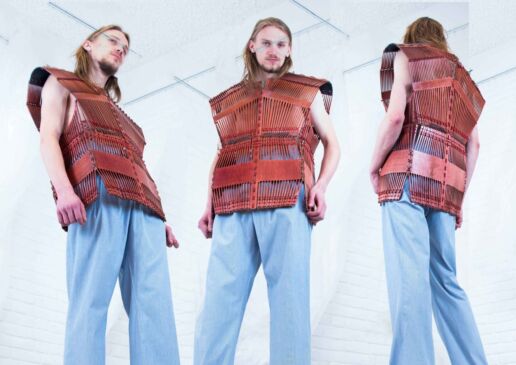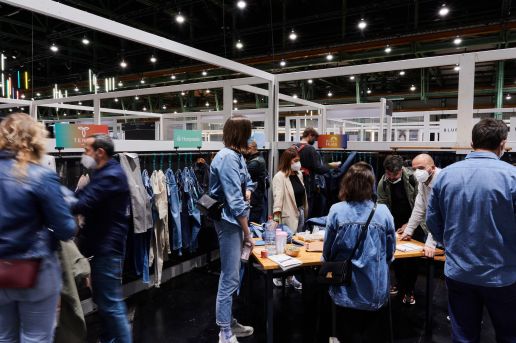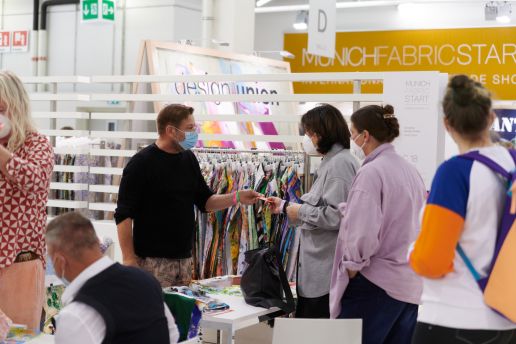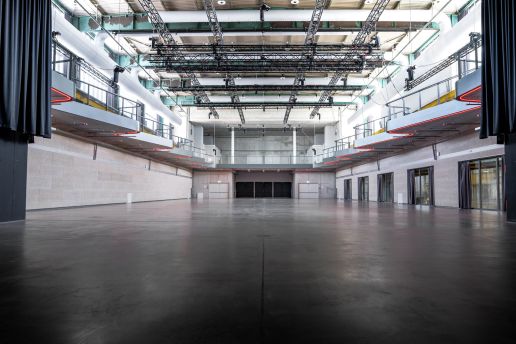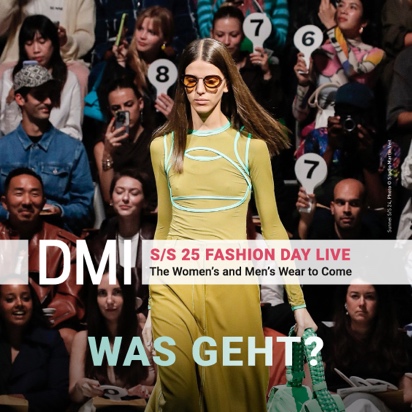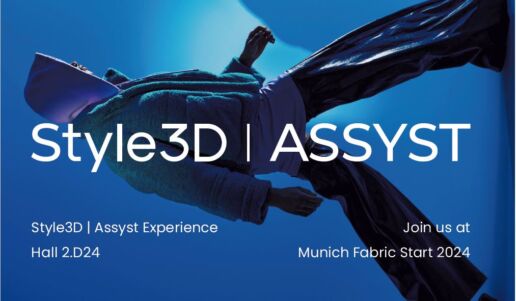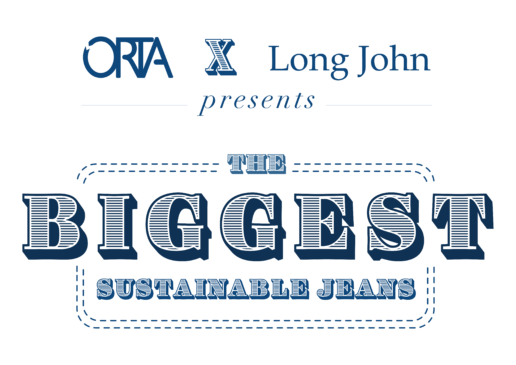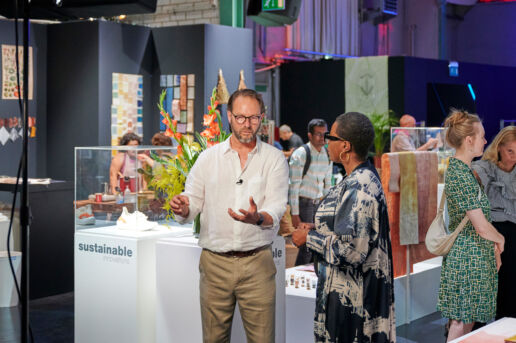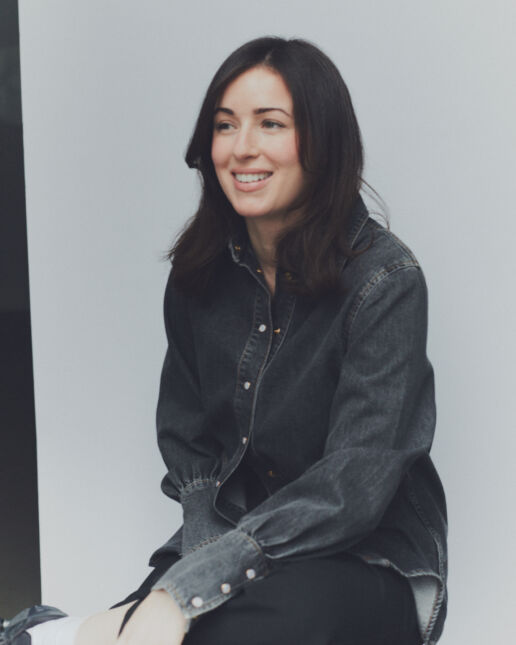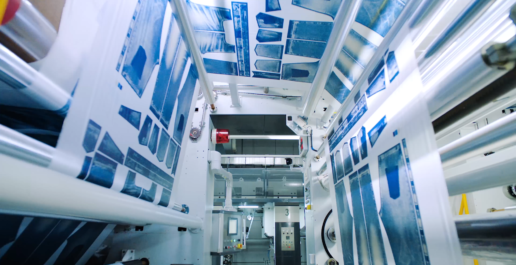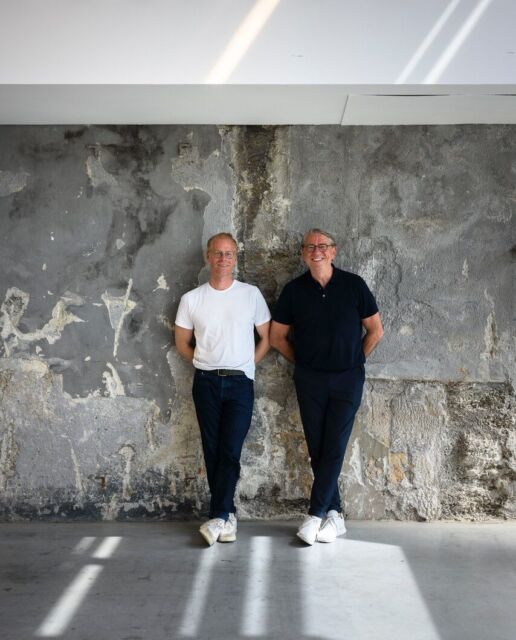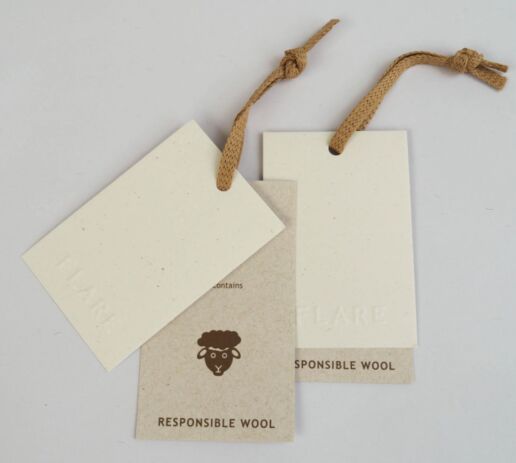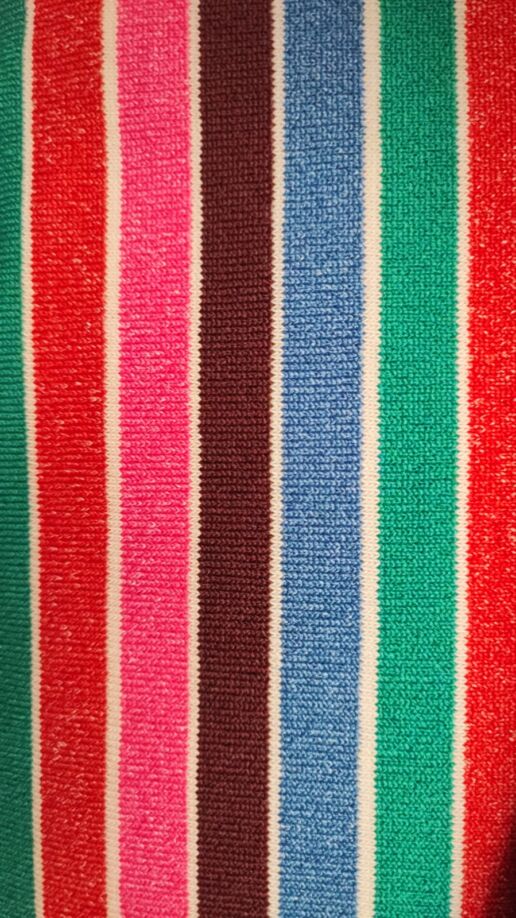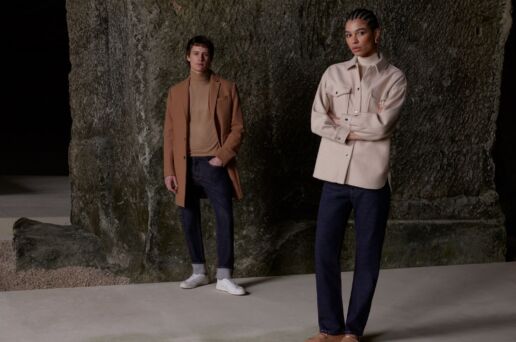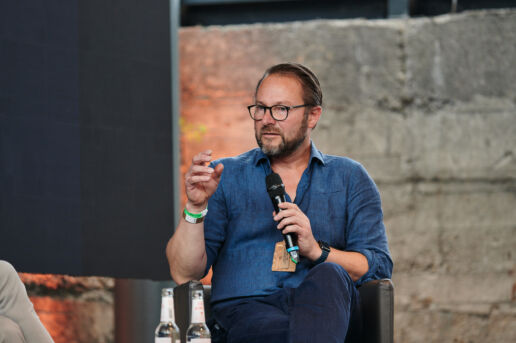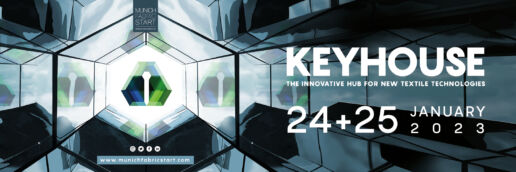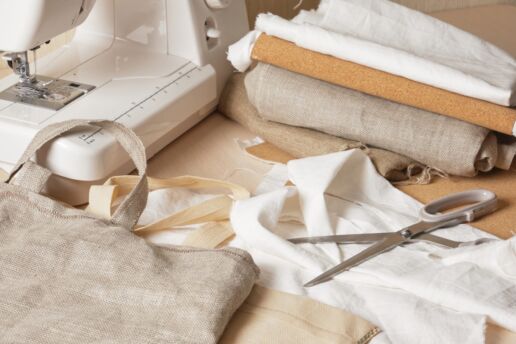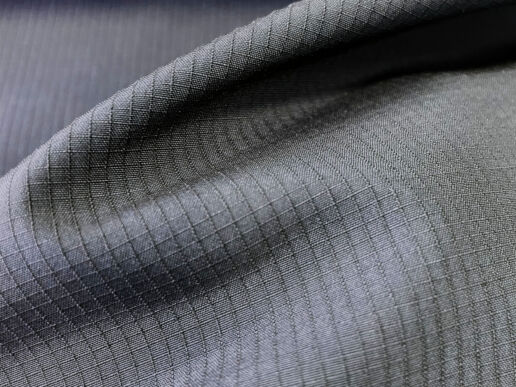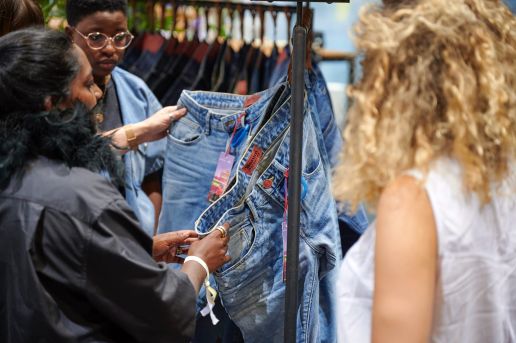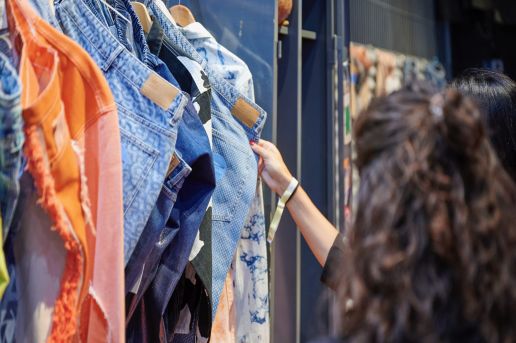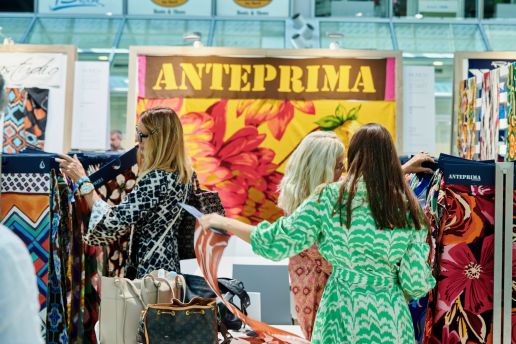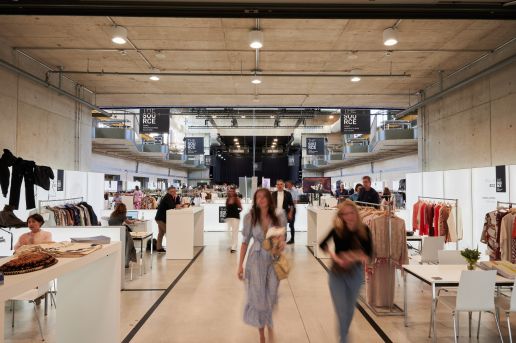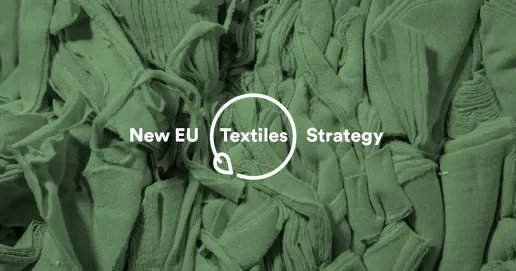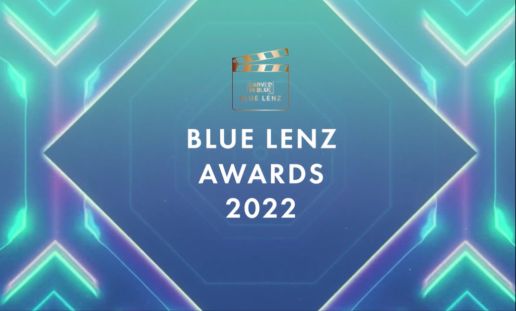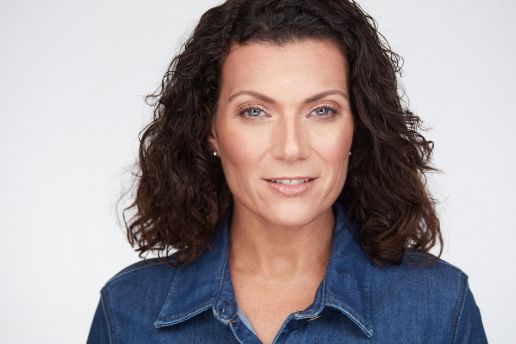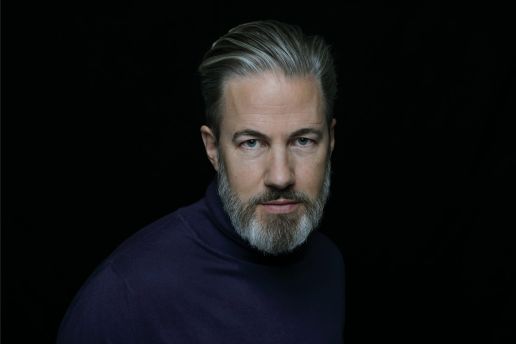Munich Fabric Start
A Suit of Armour - Sustainable innovations
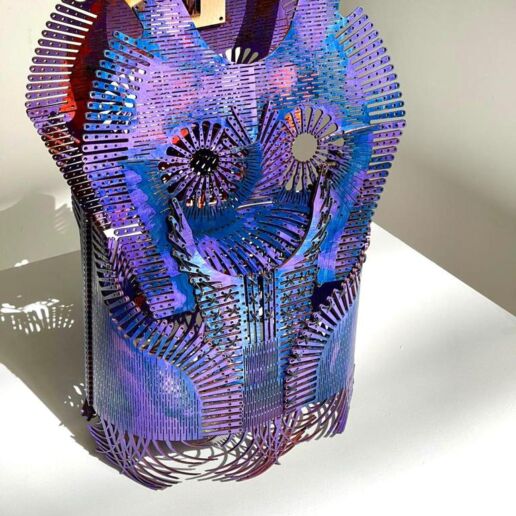
The name says it all: “Choub” means “wood” in Farsi – the material that designer Mehdi Mashayekhi draws on in his project Choub and uses innovative methods to create something new: Using digital fabrication, he has designed an abstract clothing collection for which he deconstructs the wood, giving the material new physical properties such as flexibility and stretchability.
The designer resorts to two methods: with topology optimisation, a computer-based process, he uses algorithmic models to determine the optimal shape of components in terms of load limits. The generative design method also creates new, powerful design options with the help of artificial intelligence. In this way, Mehdi Mashayekhi succeeds in solving complex requirements, distributing the weight of components and reducing manufacturing costs.
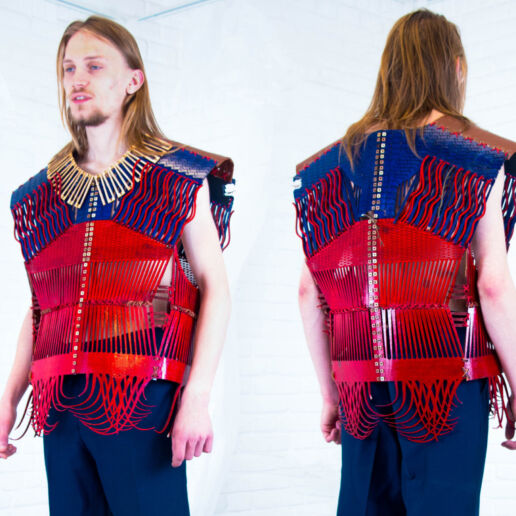
“Design is a glowing point in the cross-point between art and science, where reality meets vision.”
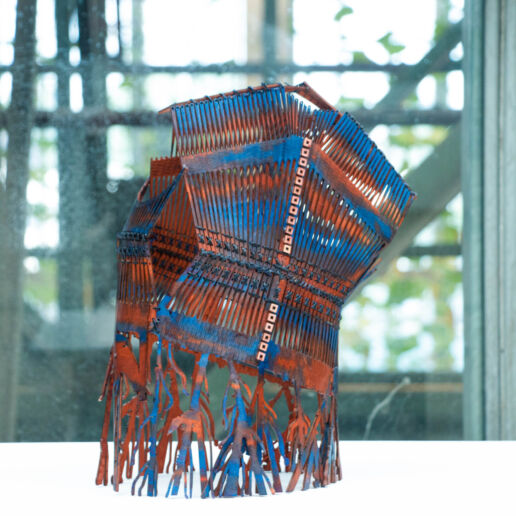
Innovative, unconventional, visionary: In the Choub project, 6mm thick plywood is used to create armour-like, portable constructions in which the wood loses its hardness and becomes flexible. Win-win: The designer optimises the use of materials in the design and at the same time provides a solution for upcycling waste. With the use of digital manufacturing, Mehdi Mashayekhi is helping to drive circularity and strengthen openness to materials and technical textiles.
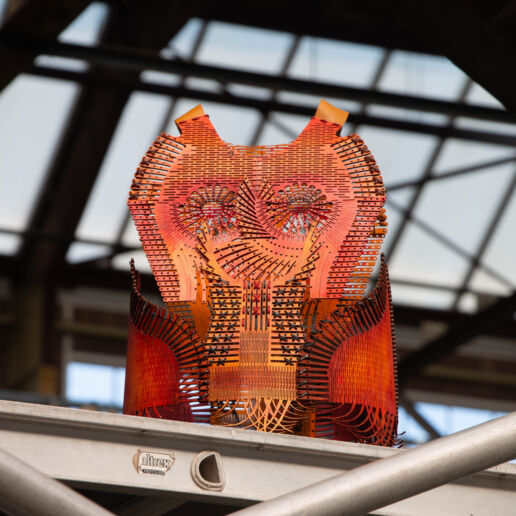
———————————————————————–
THIS MIGHT BE ALSO INTERESTING FOR YOU
SPRING.SUMMER 26 FABRIC HIGHLIGHTS & MATERIAL NOVELTIES – PART II
16. December 2024
Beautiful and contemporary prints add fresh and vibrant touches to any garment. Wild silks are offered alongside tulles with low or zero formaldehyde.
New Fabric Collection of BLOOMATI by Carvema
15. December 2024
Innovation is at the heart of our collection. We have explored new textile technologies that bring futuristic properties to fabrics.
New Fabric Collection by Paulo de Oliveira
13. December 2024
Paulo de Oliveira is a reference in sustainable production, focusing on sustainable raw materials produced in Europe by ecological processes.
A Vibe Shift is coming
Often, fashion trends are merely new variations on already familiar themes over many seasons. But then at some point there is suddenly a fundamental break, a completely new attitude to life, a completely different basic mood, a “vibe shift”. We are now at such a turning point.
The measures necessary to contain Covid 19 have been so all-encompassing that they have actually robbed us of all joy in life in the meantime. Many of us are left with the feeling that we have lost two years of our lives. This is felt particularly intensely by young people who were irretrievably robbed of part of their precious youth by the pandemic.
Greta Thunberg speaks for her entire generation when she says in retrospect: “We have become more aware that life is short.” The realisation that our time on earth is running out far too quickly is anything but new, but it is particularly topical for us now.
Fashion psychology professor Carolyn Mair also observed during the pandemic how consumers “realise that life is precious, whereas before they might have taken things for granted. They are seizing the moment.”
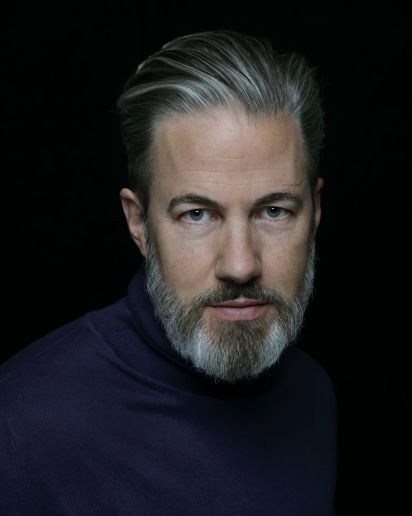
Carl Tillessen
As the 20s take shape, it becomes clear that the Lifestyle of Health and Sustainability, which has dominated the Zeitgeist for the past two decades, has reached its end. Because the L.O.H.A.S. is the opposite of the moment. It is the eternal later. If we chastise ourselves now – so he promises – we will have a healthy body and a healthy environment later. This is and remains true, but through the collective pandemic experience, the fear that we will neglect to enjoy today because of all the thinking about tomorrow has become overwhelming. We crave self-indulgence, need outlets, want to break out, go overboard, want to live as if there is no tomorrow …
GET INFORMED & INSPIRED AT MUNICH FABRIC START AT DMI:
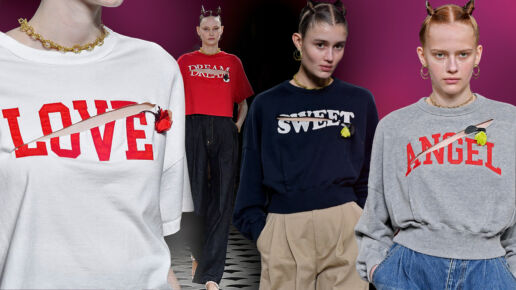
Find out what this means for fashion and what follows the Lifestyle Of Health And Sustainability at MUNICH FABRIC START at the trend presentation of DMI S/S 24
Wednesday, 25 January, at 4:00pm
in Room K1 in front of Hall 1 at MOC.
Discover more industry-changing innovations at our upcoming trade shows:
Textile Innovations: Ready To Be Supercharged in 2023?
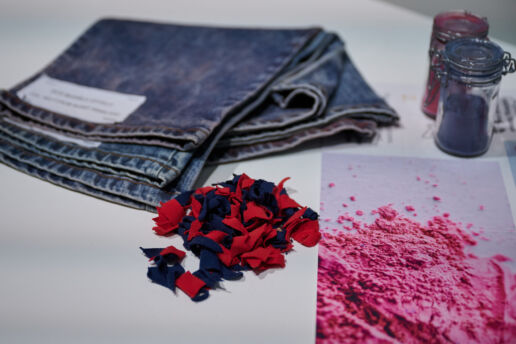
When it comes to textiles, one of the biggest challenges has been the industry taking on the responsibility to examine its processes. Although a necessary step, it is not an easy one for an industry built on foundations that date back to the mid-1700s industrial revolution. The good news is that with the help of new technology, the textiles industry is beginning to become better equipped to address most of the pain points in its supply chain, and in 2023 we may actually witness more innovations than ever being accelerated and scaled.
What To Expect in 2023
In the last few years, a shift in values has been redefining the textile industry. It is a shift driven by various technological solutions created to transform the global textile industry, so businesses can reach their sustainability and circularity goals and also understand the role that policy will most likely play in pushing value-driven fabrics forward.
So with innovation as its backbone, what can industry players seeking a more constructive view of the textile market expect in 2023?
Well, here is an overview of what is expected from the textiles space in 2023:
- There will be an acceleration and scaling of textile technologies that will position companies, small and midsize players, to explore further innovations that will help them align their business so they can adapt their practices and commit long-term.
- New fabrics will no longer survive but thrive as more research into sustainable materials and technologies increases and more brands continue to invest in sustainable and safer innovations.
- The textile industry in 2023 is expected to focus less on decadence and more on authenticity.
- We will witness the adoption of new business models that support sustainability initiatives — including supply chain traceability and the reduction of material usage.
- One of the growth drivers of the global textile market will be increasing demand for environmentally friendly and readily available natural fibres. In addition, more performance and technical fabrics will lean towards natural fibres.
- In 2023, more governments will start imposing stringent regulations. As a result, there will be more pressure on textile manufacturers to be less scattered and unorganised, especially when using toxic dyeing chemicals.
- The landscape will see an increase in market players whose USPs will be strongly driven by new technology and innovations. With a competitive edge, these material innovators bring new growth opportunities and strategies to the market.
- The textiles industry will continue to face materials, manufacturing and sustainability challenges in 2023. However, the good news is that the solutions that will continue to be explored in 2023 will be of a collaborative kind.
- Regarding future proofing manufacturing, 2023 strategies will push forward new research around new materials, digital manufacturing and sustainability for future textiles. In addition, textile manufacturers will create new supply chain models based on vertical integration, nearshoring, and small-batch production.
- In 2023, expect speed and agility to effectively tackle the challenges that slow down the growth of the textile and garment industry.
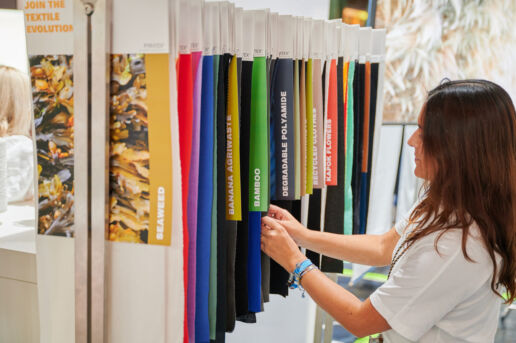
If you take away one thing, let it be this:
don’t be scared by the threat of new textile legislation distracted by the predicted digital shakedown or exhausted by the growing customer demands for sustainability.
Instead, ask yourself, if the future is promised to those who can ride through the challenges by embracing technology across their supply chain, can I afford to shy away from strategically sharpening my approach to the innovative dynamics driving the textile industry in 2023?
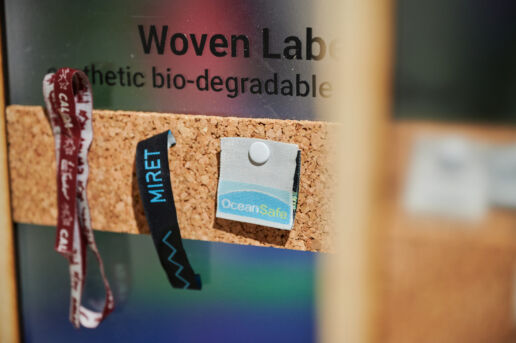
Are you interested in more in-depth facts and figures on the new textile economy?
Visit the Shape Innovate Lounge in H5 | 04 or attend the mini-lectures in the Keyhouse.
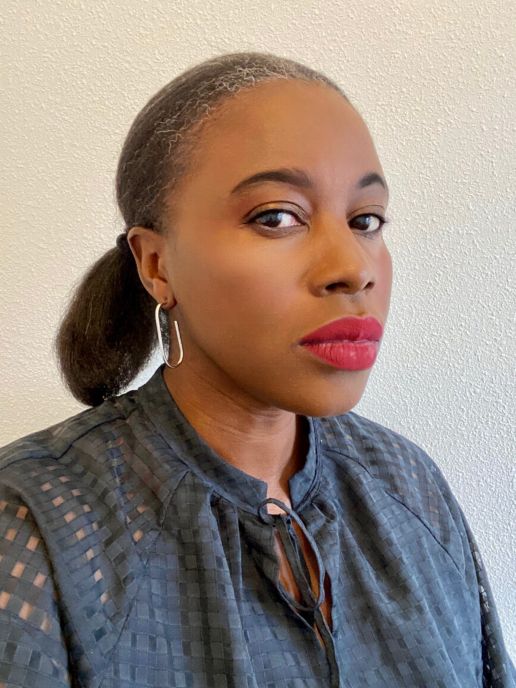
About the author
Founding editor-in-chief of Shape Innovate, Muchaneta has worked in the fashion industry for over 14 years. She is currently one of the leading influencers speaking and writing about the merger of fashion with technology and wearable technology.
Muchaneta ten Napel | m@shapeinnovate.com
This might be also interesting for you
TIMELY TIMELESS
18. January 2024
Langlebigkeit steht hoch im Kurs. Und damit ist nicht nur eine solidere Qualität gemeint, sondern auch und vor allem ein zeitloseres Design.
Digitale Klarheit im Design – ASSYST
16. January 2024
Für das Thema Nachhaltigkeit sind normalerweise Einkauf und Produktion zuständig. Wer aber über den Einsatz von abbaubaren Stoffen hinausdenkt, kann Kosten, Materialverbrauch und Profitabilität deutlich beeinflussen. Neu daran: Der Schlüssel dazu liegt in der Hand der Kreativen.
ORTA x Long John
13. January 2024
Togetherthey developed the biggest sustainable jeans everproduced to set a new milestone within the denim industry.
GANNI – Fashion made from next-gen materials
9. January 2024
With all our communication we try to speak to our community in a meaningful and honest, not perfect way, showing the hard stuff, the stuff we didn’t get right, as much as we show the stuff we nailed.
STELLA BLU PRESENTS ITS FIRST COOLTRANS DENIM COLLECTION MADE WITHOUT INDIGO
4. January 2024
This technology opens up extremely exciting possibilities.
CLARITY In conversation with the organisers of MUNICH FABRIC START about the industry, the trade show calendar and new dates
2. January 2024
CLARITY » the pursuit of structure and unambiguousness on both a large and small scale «
ReSOURCE – Autumn.Winter 24/25
24. October 2023
Certifications, recycled materials, environmentally friendly - that's what the sustainable fabrics from the ReSource range stand for.
The Fabric Trends Autumn.Winter 24/25 – Part VIII
19. October 2023
The combination of plum and matcha is futuristic and calming. Apricot Crush gives hope and awakens positivity, rounded off with a hint of intensely rusty autumn dust.
BLUEZONE CONEXXION Autumn.Winter 24/25 – Part IV
17. October 2023
Blacklight steht für dunkle Indigofarben, Schwarz, Overdyes und beschichtete Stoffe. Ihre Overdye-Technik verleiht dem Stoff eine Reihe von Farben auf beiden Seiten für zusätzliche Vielseitigkeit.
"How do our actions contribute to the better?"
What is currently happening in the industry of innovators, transformers and forwardthinkers?
Different developments can be observed – especially when it comes to upcoming designers and creators, which is very interesting yet inspiring. Newcomers are about either entering the industry or creating their own one; furthermore, they all developed a very high professionalism in everything they do and how they present their ideas. Storytelling matters, that’s why we see crafts that concern and that communicate about thoughts, materials and backgrounds. They somehow reflect on the state of the industry and/or they question current systems. Just with the eye on possibilities, not to add critique. It is a friendly way to inspire.
You just said creators are “entering the industry or creating their own one”. What do you mean by that?
Well, actually right as I say. Either people and ideas enter an industry OR they create an industry. Entering means that designers or creators just fit into an industry and can get part of it or they can develop their own techniques and make it scalable and somehow create their own. Let me give you an example: WINT Design Lab discovered a new material and also discovered how to use it in order to make it relevant for the market. Either they can enter the industry OR if they find possibilities to cover all the needs within the supply chain and develop the machines to produce in a big scale, they could go big and just create their own industry.
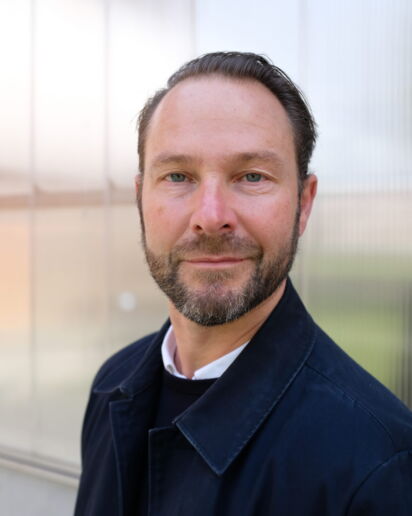
Simon Angel
What other developments can you identify?
Back in the days, let’s say about five years ago, there was mainly one person behind a new idea that was working within a tiny studio. Compared to that, everything is so much more professional: being a material designer, you can have a studio and work with employees who assist. That is nowadays how designers get ready to present their idea to the market. You need people who bridge the gap between the studio and the market. I personally recognize a huge potential in this point of professionalism, because people get ready to connect – young designers now offer representative samples and get in touch with the industry on a very professional level. Newcomers inspire the industry.

What sounds very interesting. What do the newcomers do differently?
Things that impress the industry: crafts that concern and communicate. The designers and their innovations want to tell us stories: it’s about the material, systems (and old behaviours) but also the designs. We can get glimpses into cultural backgrounds, different techniques, social aspects and so much more. For example, the project “Rootful” by Zena Holloway and the project “Choub” by Mehdi Mashayekhi show off how to create a material out of seagrass or wood with the implemented idea to use the finished garment or the designs as tools to communicate.
That’s a positive development, isn’t it?
Yes, it is. But one thing should not be forgotten: we are in the middle of a delicate discussion on the urgency of creating, within that everybody has to
put their own position into a fresh perspective. I sometimes find it important to take a bit of a distance and ask rhetorically questions like: So what? We are
leaving the era of RE-thinking we are entering an era of PRE-thinking. We can challenge ourselves in critical self-reflection with a future smile.
We should not design just to be a designer or cook just for the sake of being a chef. We should not create just to be a creator. We should not just buy new stuff, only for the sake of being a consumer. Way more, we should cook when people need food, design when designs are not good enough and create when the world needs a new product. Let’s stay critical and ask ourselves over and over again: how do our actions contribute to the better?
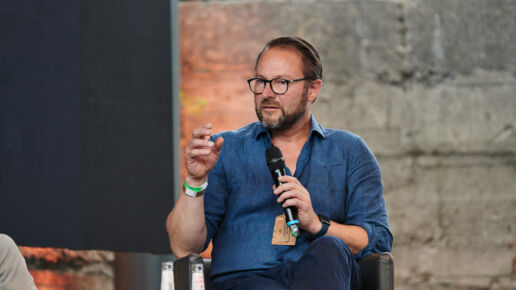
EXPOLRE AND GET INSPIRTED AT MUNICH FABRIC START
IN THE SUSTAINABLE INNOVATIONS AREA AT KEYHOUSE – H5!
Discover more industry-changing innovations at our upcoming trade shows:
Meet Saitex - the vertical Vietnamese Denim Entity
Global jeans manufacturer Saitex is going vertical as it officially announces the opening of its first denim fabric making mill in Vietnam. The new 100,000 square meter facility is located 40 minutes from its cut & sew factory near Ho Chi Minh City where 18,000 pairs of jeans are made on average per day.
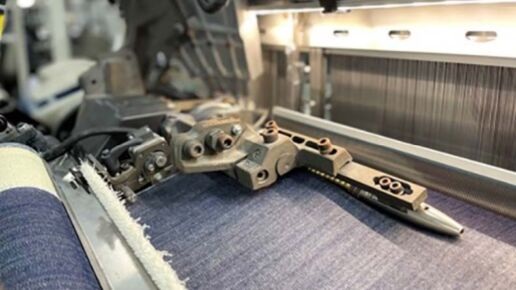
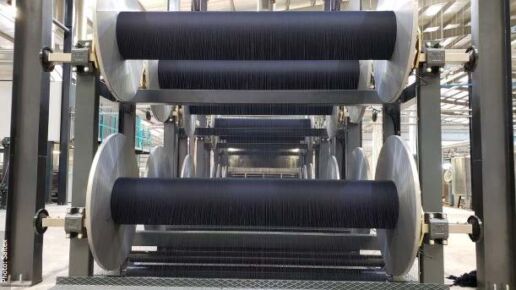
The new mill covers all operations from yarn spinning to weaving and to fabric dyeing and finishing. Saitex has announced it will produce 2 million meters of fabric per month, or 24 million yearly, and some 750 tonnes of yarn per month. These new operations have created 630 new jobs and the company says it will employ 1,000 at full capacity. As it has already done at its cut & sew factory, 20% of the jobs will be filled by people with disabilities.
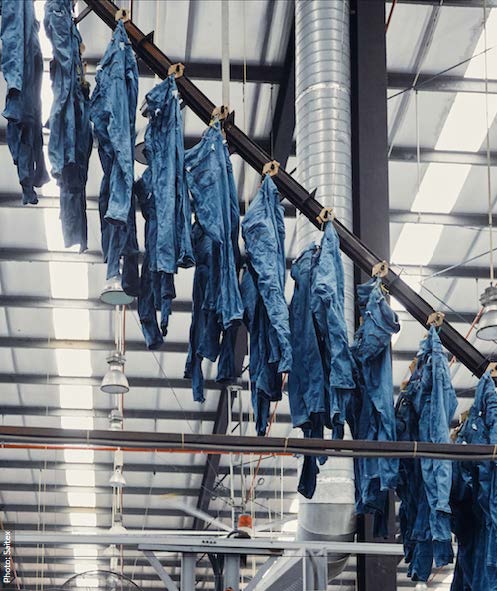
Like Saitex’s “Factory of the Future” in Los Angeles, CA, the new facility incorporates the latest and lowest impact technologies. The mill is equipped to produce yarns in pure cotton or in blends in dual-core, multiple-core and SiroSPUN technologies.
For indigo dyeing, Saitex has installed the Smart Indigo system that pre-reduces indigo via an electrochemical process. This, the company says, leads to lower CO2 emissions by 90%, requires 70% less energy and 30% less water, with oxygen as the only product released. Karl Mayer rope dyeing machines lead to further environmental savings, thanks to fewer dye bathes, and a 30% reduction in indigo and chemical usage.
Other eco-responsible features at the new site include LEED Gold Certified materials for the building, 15,000 solar panels, greywater recycling and rainwater collection systems. A vegetable garden covers 40% of the total site to feed workers and local communities. Saitex says it has also planted 6,000 trees in the industrial park, and has offset its carbon emissions by planting 50 hectares of mangroves in Vietnam, as part of its plan to contribute to climate neutrality by 2025.
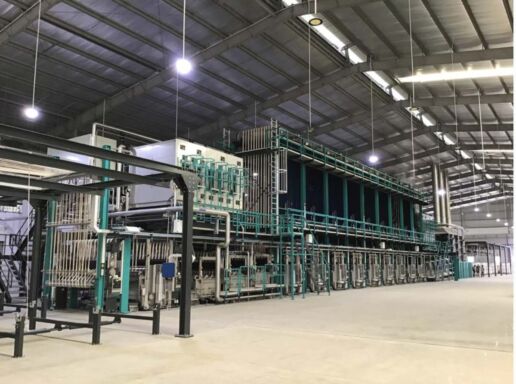

“It has been our long-term vision to close the loop on our operations. With the opening of the mill and the upcoming launch of our textile upcycling facility, Stelapop, our vision will be complete. We will close the circle, allowing us to provide unprecedented transparency in denim production and the ability to turn apparel and textile waste into high-quality goods. Our target is to become the most sustainable fabric mill on the planet making fully circular production possible for our customers.”
Sanjeev Bahl, CEO und Gründer von Saitex
This might be also interessting for you:
GANNI – Fashion made from next-gen materials
9. January 2024
With all our communication we try to speak to our community in a meaningful and honest, not perfect way, showing the hard stuff, the stuff we didn’t get right, as much as we show the stuff we nailed.
STELLA BLU PRESENTS ITS FIRST COOLTRANS DENIM COLLECTION MADE WITHOUT INDIGO
4. January 2024
This technology opens up extremely exciting possibilities.
CLARITY In conversation with the organisers of MUNICH FABRIC START about the industry, the trade show calendar and new dates
2. January 2024
CLARITY » the pursuit of structure and unambiguousness on both a large and small scale «
ReSOURCE – Autumn.Winter 24/25
24. October 2023
Certifications, recycled materials, environmentally friendly - that's what the sustainable fabrics from the ReSource range stand for.
The Fabric Trends Autumn.Winter 24/25 – Part VIII
19. October 2023
The combination of plum and matcha is futuristic and calming. Apricot Crush gives hope and awakens positivity, rounded off with a hint of intensely rusty autumn dust.
BLUEZONE CONEXXION Autumn.Winter 24/25 – Part IV
17. October 2023
Blacklight steht für dunkle Indigofarben, Schwarz, Overdyes und beschichtete Stoffe. Ihre Overdye-Technik verleiht dem Stoff eine Reihe von Farben auf beiden Seiten für zusätzliche Vielseitigkeit.
The Fabric Trends Autumn.Winter 24/25 – Part VII
12. October 2023
New Capsule Collection: luxury knitwear for timeless pieces. In a time of increasing resource scarcity, Target is responding to consumers' desire to invest in long-lasting and timeless pieces.
The latest accessory developments for Autumn.Winter 24/25 – Part IV
10. October 2023
valupa develops sustainable and circular supplies such as buckles, buttons, rings and other accessories locally from 100% renewable raw materials. In January 2023, the startup registered its first patent for a new type of modular buckle system.
PER4ORMANCE NEWS – AUTUMN.WINTER 24/25
5. October 2023
Solapel™ is the PFAS free durable water repellent technology from Sunnytex that retains 70% efficiency even after 120 washes, equivalent to 24 hours of continuous washing.
DARE & CARE
1. What can exhibitors and visitors expect at MUNICH FABRIC START in January 2023?
Sebastian Klinder: As an international fabric trade show and Germany’s leading platform for future-relevant textile innovations in the fashion sector, we are once again creating high-quality formats and offerings at MUNICH FABRIC START this season – from a broad and relevant exhibitor portfolio, to top-class lectures and panels, to trend outlooks and numerous opportunities to connect.
We are very pleased that around 900 selected international producers will once again be joining us in Munich in January to show their latest trends and innovations on a total exhibition area of around 42,500 square metres – thus demonstrating that, even in times of uncertainty, we have the courage to think big.
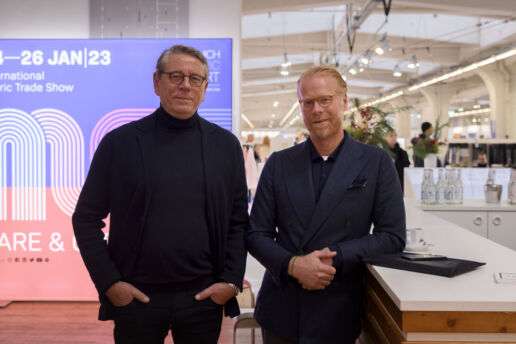
Frank Junker, Creative Director MUNICH FABRIC START; left
Sebastian Klinder, Managing Director MUNICH FABRIC START; right
“We are continuing the positive, motivated and ambitious mood that is evident at the current shows.«
Frank Junker: Nothing ventured, nothing gained – especially now. The conditions are currently changing and this requires openness to new things and the courage to move forward. Not exuberantly, but with care and deliberation. This is also reflected in our motto this year, “DARE & CARE”. Changes are taking place on all levels: from a new sense of community to the struggle for freedom with protests to hedonism and the celebration of the moment; not least the need for islands of tranquility, for joy and above all for real, human encounters. In these topics and controversies, apart from all the uncertainty, lies an immense potential for inspiration and the power to dare something.
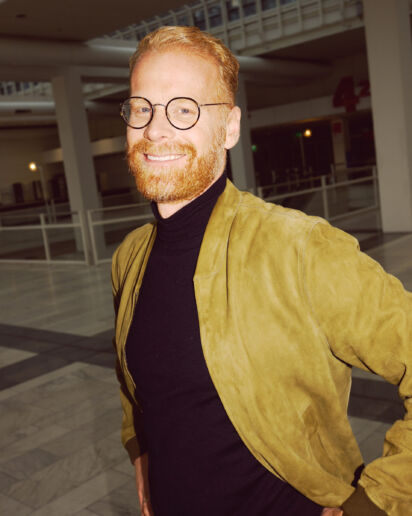
In a volatile market environment, looking ahead optimistically is easier said than done for many. As a trade show organiser, how do you look to the future?
Sebastian Klinder: We are well positioned for the current Spring.Summer 24 edition from 24 to 26 January 2023 and can be very satisfied – in a generally tense situation, MUNICH FABRIC START, BLUEZONE and KEYHOUSE are all very well booked. This makes us quite positive for the future. Demonstrating reliability, relevance and consistency is what matters now.
Frank Junker: Our task is to always be surprising, innovative and at the same time market- and solution-oriented. Once again, we have succeeded in this. Despite all the difficulties, we offer the usual high level of service, create new experiences and form a business and trend and information platform for the strong and relevant partners in the industry. That is what makes us so special. Being special pays off.
3. There is a central change from 2023 – the summer editions of MUNICH FABRIC START, BLUEZONE, KEYHOUSE and THE SOURCE will take place in the second half of July from now on. What do you expect from this?
Frank Junker: With the new date, we are positioning MUNICH FABRIC START and BLUEZONE early in the trade show calendar – so they fit perfectly into the international events and rhythms. We are ontinuing the positive, motivated and ambitious mood that is evident at the current MUNICH FABRIC START with inspiring new products, innovative content and future-oriented themes, placing them in an even more valuable time slot.
Sebastian Klinder: With the new trade show dates for MUNICH FABRIC START and VIEW, we are giving our exhibitors a wide variety of opportunities to respond to the new needs and changes in the market. We are absolutely convinced that this is an important and right step. With our new schedule, we continue to offer the already proven time slots for ordering and move forward confidently and with the courage to change.
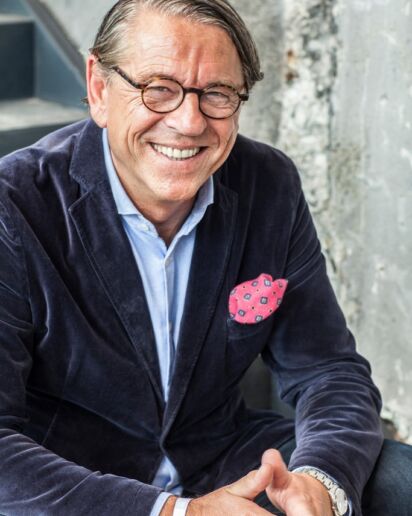
Discover more industry-changing innovations at our upcoming trade shows:
Texfash - Interview
The turnout and excitement at this year’s Munich Fabric Start matched pre-pandemic levels. What were the changes that you noticed in terms of buying practices? What were buyers looking for? Were they more circumspect? Were people taking more measured decisions?
Sustainability has become even more important than before. Many exhibitors have told us that the first questions buyers ask them are: Are your business practices are sustainable? Are your plants certified? Are your products recyclable? Those are no longer questions of marketing; they are questions of the market. Moreover, the conflict situation of skyrocketing energy prices, the current geopolitical unpredictability plus ever imminent shortages of some raw materials are necessitating fast and even further transformations towards more efficient technologies and processes. Everyone at every single position of the supply chain knows that they can no longer afford to waste resources. So yes, people are taking more measured, circumspect decisions.
Another main topic is the discussion about prices. Especially, Germany is a very price sensitive market. There are fixed retail prices brands do not want to change. Now that raw material and energy costs are rising, buyers and product managers are searching for solutions. This is quite challenging if they at the same time want to maintain their high quality and create collections with exciting, fresh and new looks, colours and materials.
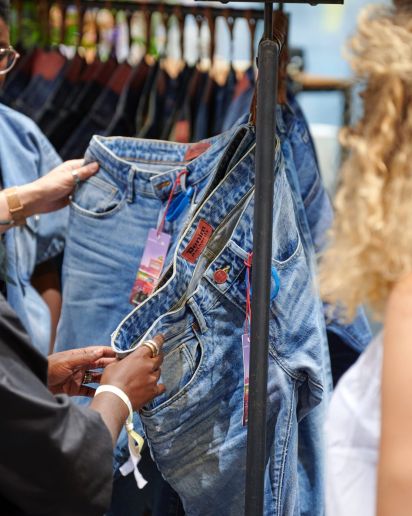
This is also the first time Munich Fabric Start was held since the announcement of the EU Textiles Strategy. Were its overall and long-term implications already reflected this year at MFS? How are companies gearing up?
Many mills and manufacturers are in the midst of or have already shifted to processes that are in accordance with the EU Textiles Strategy. Many denim manufacturers, for example, have adopted dyeing and finishing technologies that work with no or little to no water and entirely without chemicals. Whether it be Muze’s drop dye, Sharabati’s recycling system, Wiser’s oxygen-based, pumice free bleaching process—many have already taken steps to fulfilling the EU’s requirements. In terms of recycling and recyclability, we see that lot of new ideas come up to join forces to use consumer waste as new raw materials to create fashion in circularity. Many countries are looking for solutions. There is a lot to come.
The other thing that has happened, and is still happening, is the Ukraine war. Has it had any impact on Munich Fabric Start in terms of visitors? What was Russian participation like in the earlier years?
To be honest: in this specific case, the first thing we as trade show organisers care about is the people, not our performance indicators or visitor numbers. For sure, this war has an impact on all of us on a way deeper level. During the last couple of days, I had several talks to long-time friends who are affected on a personal level by having relatives in regions that have turned into a war zone, or knowing business partners who had to flee, or just personal memories of travels to places that have now become battle fields. Hearing those stories is heart breaking and it frightens me. On a personal level as well as a professional. Our industry is an exceptionally international one—conflicts are never good for globalisation; armed conflicts and wars even less so.
The Bluezone is a big canvas in itself. It’s a good place to pick up denim trends. How has denim changed since the pandemic?
On an aesthetic trend level, the biggest shift that we see is the concurrency of different trends. Denim is an absolutely ageless phenomenon. And while young generations might be willing to lever heavy qualities from the heritage scene to a wider market, those brands focussing on mid-agers probably tend to source more stretchy ones. The same applies for finishing options. Having said that, we see multiple parallel trends going on in denim. Nevertheless, our own trend forecasters once again identified a meta trend that was able to encompass multiple actual social characteristics and merge them with contemporary ones that move the fashion and design scene—which is why Bluezone’s seasonal theme is ‘Campus’. Under that term we’ve been able to condense a lot of the things that are going on in the denim world right now. And to stimulate education within a community that has a growing mindset and is able and willing to learn and change.
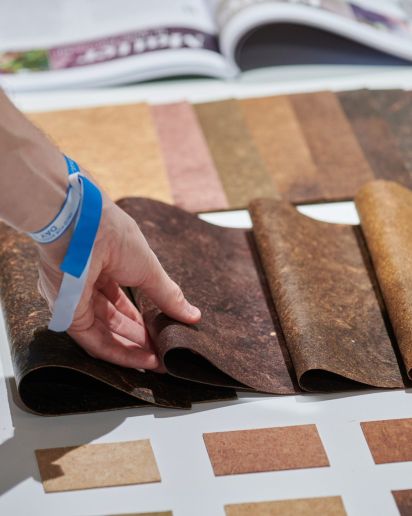
As I have already made apparent earlier, the biggest shift for our whole sector—including the denim universe—is the huge increase in consciousness. Everyone has realised what raw materials are really worth. There is more education around those contexts and a growing interest in details such as social issues or efficiency. We are aware of this demand, which is why we had an extensive series of seminars, lectures and talks at MFS this year, most of which have been centred around circularity, recycling, new materials, traceability and innovations. And we take this matter seriously—we’ve even reached out to enable a ‘coopetitive’ (cooperative competition) cooperation with the Transformer Foundation, resulting in a specialised on stage programme of trans-sectoral discussions and round table talks.
What was the need for The Source, so much so that it needed to be a sub-event and not part of the main Munich Fabric Start?
We actively decided to make it a show-in-show because we wanted to raise awareness for the potential synergies that the simultaneity of a trade show focusing on sourcing and one for fabrics make possible. Think about visiting designers or product managers, and being able to hold meetings with their brand’s fabric producers or even pattern studios and the CMT companies. Our vision is the one of a kind one-stop sourcing ecosystem.
Discover more industry-changing innovations at our upcoming trade shows:
The New EU Textiles Strategy: 15 Things You Need To Know
The New EU Textiles Strategy: 15 Things You Need To Know
A contribution of Muchaneta ten Napel, Founding Editor-in-Chief FashNerd.com
The fashion industry produces 92 million tonnes of waste. It is also responsible for 10% of the world’s carbon emissions. The ugly truth is that the way that the fashion industry does business is making an unsustainable impact on natural resources and the environment at each stage of the supply chain.
So what can be done to minimise an industry-wide problem’s carbon and environmental footprints? Well, this is where the new EU Strategy for Sustainable and Circular Textiles comes into play.
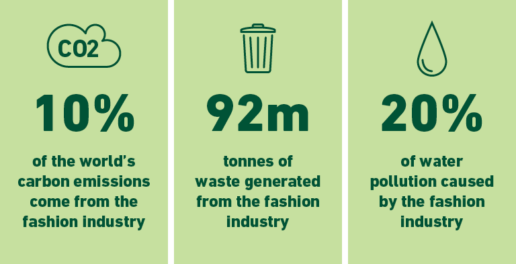

Is It Empowering the Green Transition?
More than just another set of rigid rules, the new EU textiles strategy is driven to address the need for businesses to take responsibility and act to minimise their carbon and environmental footprints. Proposed by the EU Commission, the plan has been set up to help the EU shift to a circular economy that can tackle fast fashion, textile waste and the destruction of unsold textiles. The strategy also aims to encourage businesses to participate actively in the co-creation process through their commitments to circularity and circular business models.
As part of the EU Green Deal, the strategy proposes to make sustainable products “the norm in the EU.” Pushing forward the idea that all production fully respects social rights, the plan also calls on companies to make textiles more durable, repairable, reusable and recyclable.
Bringing attention to a product’s lifecycle, the strategy focuses on design through to end-of-life. The agenda is to kickstart actions that ensure that by 2030 textile products placed on the EU market will be more eco-friendly and long-lasting.
With so much change promised, the Commission’s proposal of new rules can be complex for some to unpack. So here are ten things you need to know about the new EU Strategy for Sustainable and Circular Textiles.
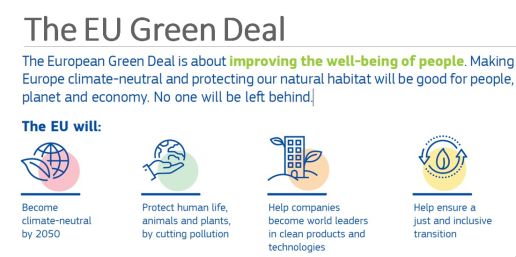
15 Things you need to know
- The new strategy is part of a much broader package, including as many as 16 new legislative actions and other policies that will directly impact the textile value chain.
- Create a model of thriving green and digital transition in manufacturing.
- The strategy will require manufacturers to give consumers more information on how to reuse, repair and recycle clothing.
- The goal is to phase out fast fashion and have more businesses commit to business models that allow for the reuse and repair of products to be widely available.
- In the textile sector, the strategy hopes producers will take responsibility for their products along the value chain, including when they become waste.
- Promoting the circular textiles ecosystem, the EU textiles strategy aims to support and accompany the textiles ecosystem throughout its transformative journey.
- By supporting innovative fibre-to-fibre recycling, the plan is to reduce, to a minimum, the incineration and landfilling of textile waste.
- Solutions and measures include more precise information, a Digital Product Passport and a mandatory EU extended producer responsibility scheme.
- The strategy highlights the need for accuracy regarding green claims by proposing new consumer rights and a ban on greenwashing.
- Reverse overproduction and overconsumption, and discourage the destruction of unsold or returned textiles.
- Propose mandatory Extended Producer Responsibility for textiles with eco- modulation of fees.
- Address the unintentional release of microplastics from synthetic textiles.
- Restrict the export of textile waste and promote sustainable textiles globally.
- Incentivise circular business models, including reuse and repair services.
- Adopt favourable taxation measures for the reuse and repair sector. Lastly, the new EU Strategy for Sustainable and Circular Textiles end game is to make the EU market more friendly to the environment, circular, and energy-efficient and bring balance back to global supply chains. So to conclude, yes, the EU textiles sustainability strategy is very ambitious, but this is why it is critical that it is implemented correctly.
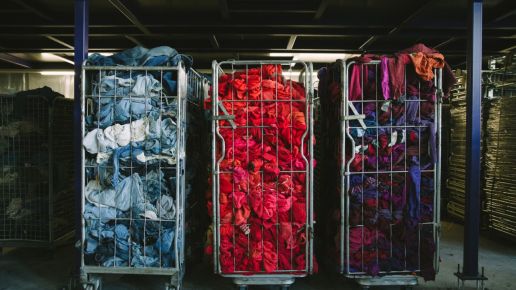
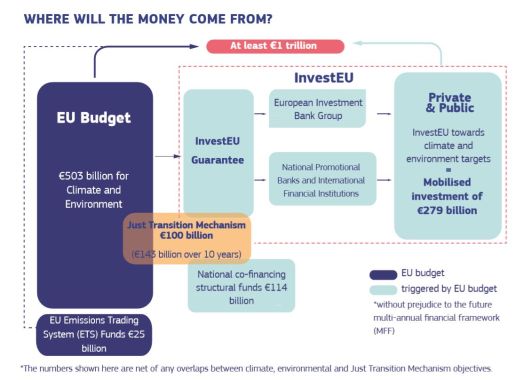
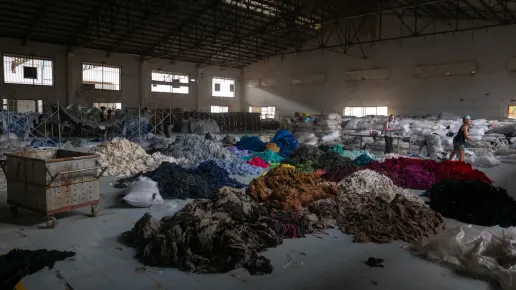
Are you interested in more in-depth facts and figures of the new textile economy?
Visit the FashNerd.com Lounge at H5 | 28 or join their mini lectures Keyhouse.

About the author
Founding editor-in-chief of FashNerd.com, Muchaneta has worked in the fashion industry for over 14 years. She is currently one of the leading influencers speaking and writing about the merger of fashion with technology and wearable technology.
Muchaneta ten Napel | editor@fashnerd.com
THIS MIGHT BE ALSO INTERESTING FOR YOU
TIMELY TIMELESS
18. January 2024
Langlebigkeit steht hoch im Kurs. Und damit ist nicht nur eine solidere Qualität gemeint, sondern auch und vor allem ein zeitloseres Design.
Digitale Klarheit im Design – ASSYST
16. January 2024
Für das Thema Nachhaltigkeit sind normalerweise Einkauf und Produktion zuständig. Wer aber über den Einsatz von abbaubaren Stoffen hinausdenkt, kann Kosten, Materialverbrauch und Profitabilität deutlich beeinflussen. Neu daran: Der Schlüssel dazu liegt in der Hand der Kreativen.
ORTA x Long John
13. January 2024
Togetherthey developed the biggest sustainable jeans everproduced to set a new milestone within the denim industry.
GANNI – Fashion made from next-gen materials
9. January 2024
With all our communication we try to speak to our community in a meaningful and honest, not perfect way, showing the hard stuff, the stuff we didn’t get right, as much as we show the stuff we nailed.
STELLA BLU PRESENTS ITS FIRST COOLTRANS DENIM COLLECTION MADE WITHOUT INDIGO
4. January 2024
This technology opens up extremely exciting possibilities.
CLARITY In conversation with the organisers of MUNICH FABRIC START about the industry, the trade show calendar and new dates
2. January 2024
CLARITY » the pursuit of structure and unambiguousness on both a large and small scale «
ReSOURCE – Autumn.Winter 24/25
24. October 2023
Certifications, recycled materials, environmentally friendly - that's what the sustainable fabrics from the ReSource range stand for.
The Fabric Trends Autumn.Winter 24/25 – Part VIII
19. October 2023
The combination of plum and matcha is futuristic and calming. Apricot Crush gives hope and awakens positivity, rounded off with a hint of intensely rusty autumn dust.
BLUEZONE CONEXXION Autumn.Winter 24/25 – Part IV
17. October 2023
Blacklight steht für dunkle Indigofarben, Schwarz, Overdyes und beschichtete Stoffe. Ihre Overdye-Technik verleiht dem Stoff eine Reihe von Farben auf beiden Seiten für zusätzliche Vielseitigkeit.
Blue Lenz Denim Video Awards
Beginning back in 2021, the BLUE LENZ DENIM VIDEO AWARDS is an annual celebration of creativity, technical excellence and innovation in the denim industry.
The Awards take place at Bluezone, the Munich Fabric Start international trade show for denim, street and sportswear.
The BLUE LENZ YouTube channel was launched in January 2020 with the aim to capture and curate all the latest original video content cover stories, education, sustainability initiatives, fabric innovations and trends from the denim community.
Currently hosting more than 430 videos and with upwards of 1,000 followers, the aim is to shine the spotlight on the best and the brightest blue videos, and recognize the best ones with an awards competition in collaboration with Bluezone.
For those of us who grew up in the era of MTV we recall the launch of music videos. It was at that time that music and videos came to life and that eventually led onto the birth of the MTV Music Video Awards in 1984.
We asked ourselves “Why can’t the denim industry have the same?”
As a category of textiles that boasts some of the deepest roots and richest of histories, denim has been an influential component of popular culture and fashion for centuries. denim is ubiquitous. Denim has impacted music, art, politics, culture – and that is what we hope is reflected in the content of the Blue Lenz Denim Video Awards.
In an effort to highlight and champion the best in our industry, as well as to credit people and teams behind each of the denim videos, we nominated videos in 8 categories. We enlisted a group of esteemed judges from around the world to debate and deliberate the winners, and it was those winners that were recognized today at the Bluezone/ Munich Fabric Start event.
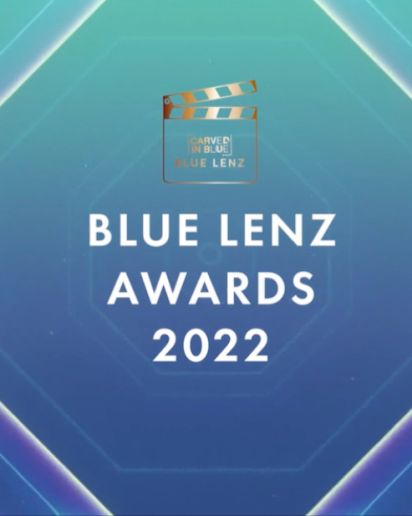
Our judging panel consisted of:
Margherita Verlicchi
Menabo
(ITALY)

Michelle Branch
Markt & Twigs
(USA)
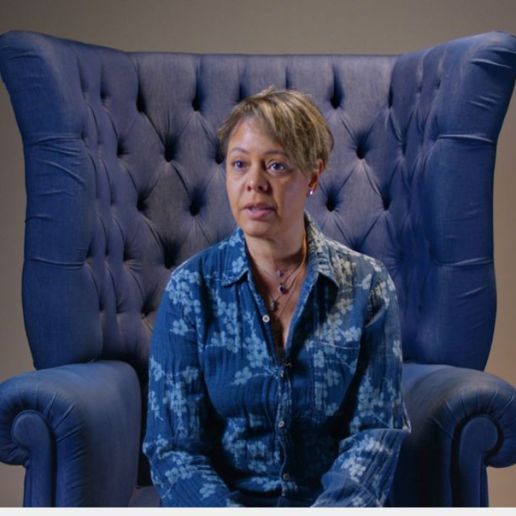
Wouter Munnichs
Long John Denim (NETHERLANDS)
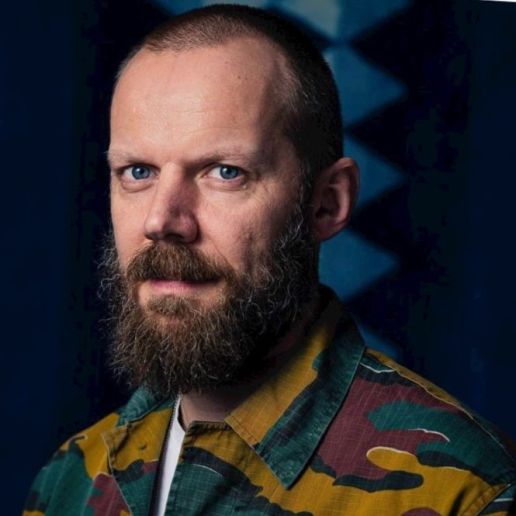
Panos Sofianos
Bluezone
(GERMANY / GREECE)
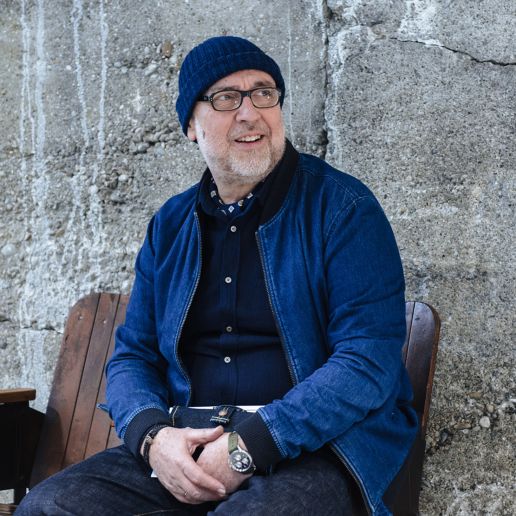
Kara Nicholas
Denim Expert
(USA)

Best Educational Video/ Series
WINNER
Transformers ED Series by Transformers Foundation
2nd place: Kingston University MA Fashion – Denim Project
3rd place: Ever Evolving Talks by Calik Denim

Best Denim Design/ Collection
WINNER
2nd place: WASSSH! SPAIN IS DIFFERENT by Jose Medina
3rd place: “NAVEENA DENIM MIILLS X ENDRIME® X OFFICINA + 39 “FUTURE CELLULOSIC COLLECTION””
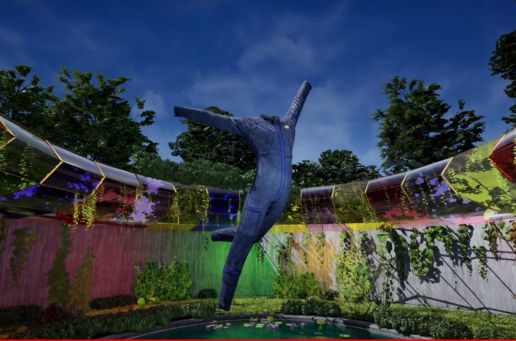
Best Sustainability - Connection to the UN SDGs
WINNER
2nd place: Blackhorse Lane Ateliers – ‘Community Membership’ APRIL 2022
3rd place tie: Celebrating Women at AGI – Women’s Day
3rd place tie: Collaboration with the Textile Institute of Pakistan
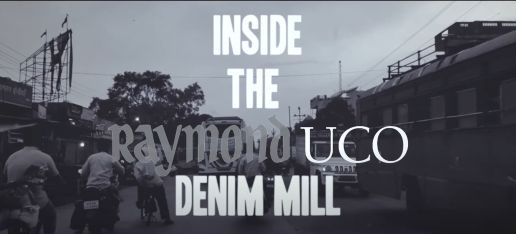
Future Forward
WINNER
2nd place: ORTA – ALWAYS TAKE THE SCENIC ROUTE
3rd place: Advance Denim – Jeans Redesgin
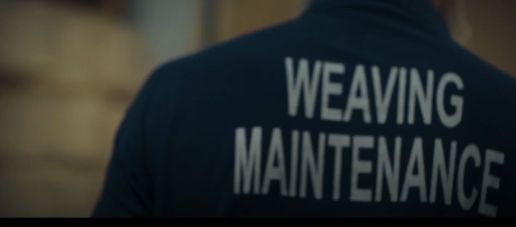
Honorable Mention
WINNER
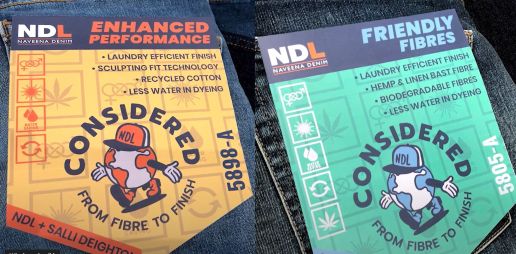
Best Overall Video
WINNER
2nd: Hempy Colleciton by Bossa
3rd : NDM X OfficinaX Endrime

We also want to thank our hosts, Blue Zone at Munich Fabric Start.
Photo images available upon request from the live presentation.
Discover further industry-disrupting innovations at our upcoming shows:
The twenties are taking shape
Trend analyst Carl Tillessen not only observes; he anticipates. As a member of the management and chief analyst of the Deutsches Modeinstitut, he knows the textile and fashion to the smallest detail. Here he reveals the upheavals and trend changes that are in store for us.
How can you foresee which trends will develop?
What role does culture play, do current events play?
As part of an association of the most important trend institutions in the world, DMI always sets the key directions for a season two and a half years in advance. To think that far ahead, it is not enough to sell people something as a trend that is already visible in Milan, Paris and New York. You have to recognise trends before they become visible. Let me explain it this way: A bad trend analyst and a good trend analyst go to a bar. They see that the guests are nibbling salty biscuits. The bad trend analyst says: ‘People are eating savoury biscuits. We need savoury biscuits.’ The good trend analyst says, ‘People will get thirsty soon. We need drinks.’
Are people consuming more again right now? If so, why? Does compensation (e.g. for the time lost during the pandemic years) play a role?
Yes and no: No, little is being consumed at the moment. Yes, compensation plays a big role. Before the pandemic, people had increasingly spent money on experiences and less on things. Then the pandemic came and many experiences were not possible or not allowed. So people spent more money on things again. Accordingly, retail sales in the last two years have been much higher than before Corona. Now people are trying to make up in one summer for everything that was cancelled in the last two summers – trips, weddings, festivals, concerts … That costs a lot of money. And this money is missing from the shopping budget.

Carl Tillessen
In view of the very contradictory developments – sustainability and minimalism on the one hand, hedonism and expression through consumption on the other – what forecast would you make for the next few years?
The pandemic has polarised our society in this respect as well. While the majority of people simply wanted their old lives back and to continue exactly where they left off, it became apparent after only a few weeks that the powerful cultural elite took the sitting-at-home-and-cleaning-out-the-closet as an opportunity to rethink their overconsumption and to make a resolution to live more frugally after the pandemic. This idea of consumerism is now in the world, and it is only a matter of time before it becomes mainstream.
What are the challenges and opportunities ahead for the industry?
So far, fashion companies have been able to answer the demand for more sustainability with a more sustainable quality of their products. They replaced cotton with organic cotton, for example, and customers simply bought the same thing in green. But now customers are additionally questioning the quantities. It is less and less about what they want to buy and more about how much they want to buy. Adapting to this new situation is currently the big challenge and opportunity for the industry.
Do your trend analyses differ for the different price segments?
Yes, also. But due to people’s hybrid consumption, this is becoming less and less important. Luxury fashion is increasingly being bought by people who can’t actually afford it, and cheap fashion is also being bought by people who don’t actually need it. In this respect, buying decisions are determined much less by how much someone earns than by what style world they want to live in.
What long-term changes do you see in the next few years?
We are actually just at the end of a macro trend and the beginning of a new one. It’s about more than just a fashion variant. It’s about a new style, a new music direction, a new attitude to life. The twenties are taking shape. But more on that elsewhere.
Get informed & inspired at the MUNICH FABRIC START at DMI:
Get informed & inspired at the MUNICH FABRIC START at DMI:
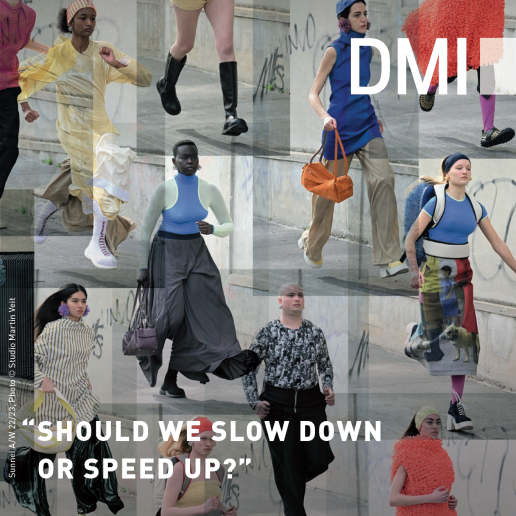
TREND LECTURE: Should we slow down or speed up?
Wednesday, 31 August 2022 from 4:00 – 5:00 pm
in room K1 in front of Hall 1, MOC
TREND BRIEFING:
Ask our analysts in a personal conversation specifically about impulses, colours and materials that are relevant for your products,
your target group and your brand essence.
Tuesday, 30 August from 9:30 am to 6:30 pm
Wednesday, 31 August from 9:30 am to 3:00 pm


